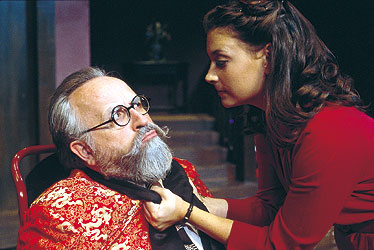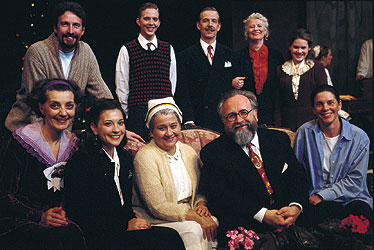| |
March 25, 2004
Theater professor and department chair Mike Abbott ’85 was studying theater at Wabash in the mid-1980s when professors Jim Fisher and Dwight Watson often cast several actors from the Crawfordsville community in their plays, as well as special guests from the Wabash faculty and staff. | |  | | Anna Fisher tells of her dad: "With Jim, Dana, and Anna cast in these roles, you had instant chemistry. The two main characters in the play who get to tell him off are, in real life, his wife and his daughter!" | "They were in their early years at the College, and they could tap into this community of people on campus and in town who were right around the age we really needed them to be for these parts," Abbott recalls. "It’s very hard to cast students in middle-aged roles. They can play 13 to 25, but past that, it gets real difficult. It doesn’t quite work. It’s easier to have them play a 60 or 70-year-old man than a middle-aged one!" Abbott faced a similar challenge this fall staging his production of George S. Kaufman and Moss Hart’s The Man Who Came to Dinner, a comedy classic packed with middle-aged parts. He turned not only to his mentors’ solution, but to the mentor himself, casting Fisher as Sheridan Whiteside, "the world’s rudest man;" his wife, Dana, as the nurse whom he harasses but who ultimately gets the best of him; and his daughter, Anna, as his long-suffering secretary. The play featured students Donald Claxon, Aaron Drake, Denis Farr, Wayne Lewis, Chris Mehl, Reynaldo Pacheco, Zach Parrett, Jonathan Schwarz, Jim Stephens, Paul Stephens, Pete Wagner, and Richard Winters. Abbott also brought in veteran Crawfordsville actress Sue Ann Ford, guest actress Hollis McCarthy, Wabash staffers Richard Bowen and Diane Norton, a chorus of Crawfordsville elementary school kids, and high school senior Abby Gillan. Then, to the delight of both cast and audience, he set up special guest walk-ons by Dean of the College Mauri Ditzler ’75 and professors Peter Frederick, Aus Brooks ’61, and Warren Rosenberg. "You always get a special little buzz when the dean of the college or another Wabash ‘celebrity’ walks onstage in costume playing a character," Abbott says. And the audience got the joke when Frederick and Brooks, who are retiring this year, entered the action as convicts with "just one year left to serve before they go free." "That kind of casting gets this metatheater going—the audience starts thinking, Isn’t that cool that he’s doing that, or, I wonder if he’ll be any good. It’s another level on which to enjoy the play, and all part of the fun of doing theater in this sort of community." | |  | | A creative community reunited: (front row) Diane Norton, Anna Fisher, Dana Fisher, Jim Fisher, costumer Laura Connors; (second row) Michael Abbot, Richard Winters '06, Richard Bowen, Sue Ann Ford, and Abby Gillian. | And the cast became a community in itself. "There was great camaraderie—the Crawfordsville residents hung out with the students and everyone got to know each other. And the social life outside the rehearsal process was terrific. Diane Norton, Dana Fisher, and Sue Ann Ford would make these big meals and the guys would come in and feast." Bringing Crawfordsville residents and Wabash students together created teachable moments for both groups. "Some students forget that Crawfordsville exists except when they want someone to do something for them, and that notion is antithetical to the process of making theater. Bringing in people from the broader community breaks down those walls—they’re not there to be of service to you, but to be equal partners and your trusted collaborators. "Some of these guys don’t realize that there are tremendously talented people out there; as they work together, a lot of assumptions melt away. "And the students are used to taking risks, to putting it all out there, and you could see their confidence and encouragement putting at ease some of the older actors who hadn’t been onstage for awhile." Directing long-time mentor-turned-colleague Fisher presented its own risks and rewards for Abbott. "I’ve worked with Jim since my student days here, so we’ve figured out how to be collaborative together. But we’re both directors with different approaches to the rehearsal process. So being an actor in this play meant Jim had to turn that director switch off. I tried to adjust my approach to get the best from him, and he adapted to my way of working, too. "Jim will always be one of my mentors," Abbott says. "There’s a father-son relationship there, too. But when we work together, we have to negotiate how that works. He’s been very generous with me in that. He can see how I’ve consciously rejected some things that he taught me, yet he seems to understand that’s all part of the process. That requires a certain level of maturity that I really respect in him." Fisher’s adaptability was representative of the entire cast and crew. "This community and faculty/staff involvement in a production stretches us in all kinds of ways," Abbott says. The effort to involve members of the Wabash and Crawfordsville communities in each others’ lives, he explains, "is all part of a much larger initiative we’re making with the arts here. We decided to make fine arts and Visiting Artists Series events free to the public, we’ve brought the community in, we’ve continued to build the Friends of the Fine Arts program, and it’s paying off. All you have to do is go to any of these events and see how many people are there—kids, families, students, faculty, staff—all coming out in big numbers. "For The Man Who Came to Dinner, we just happened to have a lot of them on stage!"
|